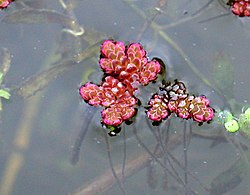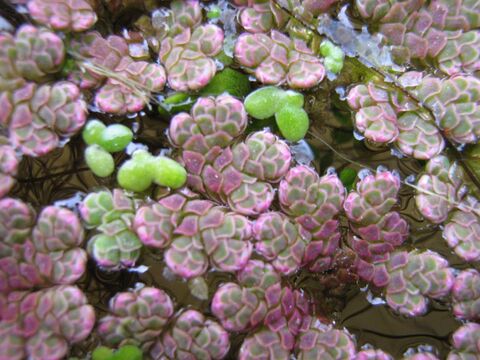Biology:Azolla filiculoides
| Azolla filiculoides | |
|---|---|

| |
| Scientific classification | |
| Script error: No such module "Taxobox ranks".: | Plantae |
| Script error: No such module "Taxobox ranks".: | Tracheophytes |
| Script error: No such module "Taxobox ranks".: | Polypodiophyta |
| Script error: No such module "Taxobox ranks".: | Polypodiopsida |
| Script error: No such module "Taxobox ranks".: | Salviniales |
| Script error: No such module "Taxobox ranks".: | Salviniaceae |
| Script error: No such module "Taxobox ranks".: | Azolla |
| Script error: No such module "Taxobox ranks".: | <div style="display:inline" class="script error: no such module "taxobox ranks".">A. filiculoides |
| Binomial name | |
| Azolla filiculoides | |
| Synonyms[1][2] | |
| |
Azolla filiculoides (water fern) is a species of aquatic fern. It is native to warm temperate and tropical regions of the Americas, and has been introduced to Europe, North and sub-Saharan Africa, China , Japan , New Zealand, Australia , the Caribbean and Hawaii.[3]
It is a floating aquatic fern, with very fast growth, capable of spreading over lake surfaces to give complete coverage of the water in only a few months. Each individual plant is 1–2 cm across, green tinged pink, orange or red at the edges, branching freely, and breaking into smaller sections as it grows. It is not tolerant of cold temperatures; in temperate regions it largely dies back in winter, surviving by means of submerged buds. It harbors the diazotrophic organism Nostoc azollae in specialized leaf pockets. This ancient symbiosis allows N. azollae to fix nitrogen from the air and contribute to the fern's metabolism.[4][5]
Fossil records from as recent as the last interglacials are known from several locations in Europe (Hyde et al. 1978). 50 million years ago, a species similar to Azolla filiculoides may have played a pivotal role in cooling the planet in what is known as the Azolla event.[6]
Azolla filiculoides was one of the first two fern species with a reference genome published.[7][6]
Identification
The only sure method of distinguishing this species from Azolla cristata (long incorrectly known as A. caroliniana) is to examine the trichomes on the upper surfaces of the leaves. Trichomes are small protuberances that create water resistance. They are unicellular in A. filiculoides but septate (two-celled) in A. cristata.[8]
Cultivation
The species has been introduced to many regions of the Old World, grown for its nitrogen-fixing ability that may be used to enhance the growth rate of crops grown in water, such as rice, or by removal from lakes for use as green manure.[9] A. filiculoides is frequently cultivated in aquariums and ponds, where it can become easily dominant over other species.
Invasive species
A. filiculoides was first recorded in Europe in 1870s–1880s, when the species may have been accidentally transported in ballast water, with fry, or directly as an ornamental or aquarium plant. It was introduced into Asia from East Germany in 1977 as an alternative to the cold susceptible native strain of A. pinnata, used as a green manure in the rice industry. A. filiculoides has also been spread around the world as a research model plant for the study of Azolla–Anabaena symbiosis. In the areas of introduction, A. filiculoides is capable of rapid growth, especially in eutrophic ecosystems, and outcompete native aquatic plants. The dense mat of A. filiculoides causes lack of light penetration and an anaerobic environment due to detritus decomposition, causing a drastic reduction of water quality, aquatic biodiversity and ecosystem funcion.[10][11]
See also
Gallery
-
Close-up of a leaf
-
A. filiculoides (pink-tinged) with Lemna minor
-
Single Azolla filiculoides plant showing the roots
References
- ↑ Cite error: Invalid
<ref>tag; no text was provided for refs namednobanis - ↑ "Tropicos". http://www.tropicos.org/Name/26602847?tab=synonyms.
- ↑ Azolla filiculoides (water fern) - Invasive Species Compendium https://www.cabi.org/isc/datasheet/8119
- ↑ "Azolla Ferns without Nitrogen Fertilizer". Frontiers in Plant Science 8: 442. 2017-03-31. doi:10.3389/fpls.2017.00442. PMID 28408911.
- ↑ Meeks, John C. (2009). "Physiological Adaptations in Nitrogen-fixing Nostoc–PlantSymbiotic Associations". in Pawlowski, Katharina. Prokaryotic Symbionts in Plants. Microbiology Monographs. 8. Berlin, Heidelberg: Springer. pp. 181–205. doi:10.1007/7171_2007_101. ISBN 978-3-540-75460-2.
- ↑ 6.0 6.1 "Can A Tiny Fern Help Fight Climate Change and Cut Fertilizer Use?" (in en-US). 2018-07-11. https://e360.yale.edu/digest/can-a-tiny-fern-help-fight-climate-change-and-cut-fertilizer-use-azolla.
- ↑ "Fern genomes elucidate land plant evolution and cyanobacterial symbioses" (in En). Nature Plants 4 (7): 460–472. July 2018. doi:10.1038/s41477-018-0188-8. PMID 29967517.
- ↑ "Taxonomy of the American Azolla Species (Azollaceae): A Critical Review". Systematics and Geography of Plants 74 (2): 301–318. 2004.
- ↑ A., Lumpkin, T. (1982). Azolla as a green manure use and management in crop production.. Westview Press. ISBN 0-89158-451-X. OCLC 708561329. http://worldcat.org/oclc/708561329. Retrieved 2021-03-21.
- ↑ Azolla filiculoides (water fern) - Invasive Species Compendium https://www.cabi.org/isc/datasheet/8119
- ↑ Hussner, Andreas (2010-10-25). "Azolla filiculoides". NOBANIS – Invasive Alien Species Fact Sheet. https://www.researchgate.net/publication/273259727. Retrieved 2021-06-02.
Further reading
- Welsh ferns: clubmosses, quillworts, and horsetails.. National Museum of Wales. 1978. ISBN 0-7200-0210-9. http://archive.bsbi.org.uk/Welsh_Ferns.pdf.
- Waterplants in Australia. Potts Point, Sydney, Australia: Sainty and Associates. 2003. ISBN 0-9581055-1-0. http://www.publish.csiro.au/pid/3784.htm. Retrieved 2013-08-31.
External links
- Azolla Fern Project Regeneration
- {{citation
| mode = cs1 | title = Azolla filiculoides | work = Germplasm Resources Information Network (GRIN) | url = | publisher = [[Organization:Agricultural Research ServAgricultural Research Service (ARS), United States Department of Agriculture (USDA) | access-date = }}
- Flora of North America: Azolla filiculoides
- USDA Plants Profile: Azolla filiculoides
- Plants for a Future: Azolla filiculoides
- NSW Flora Online: Azolla filiculoides
Wikidata ☰ Q2705087 entry
 |



